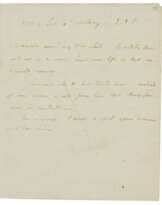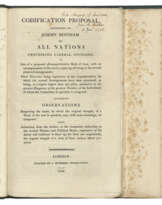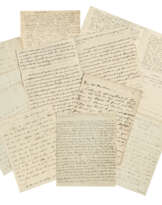ID 1109082
Los 282 | James Mill (1773-1836) and Jeremy Bentham (1748-1832)
Schätzwert
£ 4 000 – 6 000
Two conjoined autograph letters signed, 7 September 1820
Autograph letter signed (‘J Mill‘) to [Mary Sophia] Bentham, Gatcombe Park ('in Gloucestershire, Mr. Ricardo's'), 7 September 1820, with an autograph letter by Jeremy Bentham added as a post-script on the conjugate leaf
3 pages together, 227 x 190mm, bifolium, address panel with four lines by Bentham’s amanuensis on the integral verso. Provenance: Christie’s, 28 June 1995, lot 355.
Civilising and educating the teenage John Stuart Mill; with a letter from Jeremy Bentham to his brother discussing the divorce case of Queen Caroline. His father wholeheartedly concurs with Mary Bentham: 'From what you have stated I can have no doubt of its being a matter of first rate importance for John to remain in your society and under your tuition for a few months longer. There is not one of the circumstances which you point out as of importance to him with respect to which I do not most fully concur in your sentiments. The want of attention to ordinary objects which you remark, is the grand defect of his previous education, its correction of it, by the impulse of novelty, and by your kind instructions, was one of the great advantages which I expected him to draw from this visit [...] the boy writes to me with a strong sense of the importance of all that you point out to him and with infinite gratitude both for your suggestions and for the manner of them [...] example can be more useful to John, whose exclusive attention to books has blunted the quickness of his attention to other things'. He expresses at length his gratitude to Mary Bentham, explaining that he is sending this letter to Jeremy in London, to be forwarded to Toulouse.
When John Stuart Mill reached the age of 14, a prodigy academically many years in advance of his contemporaries, his father, who had been his stern and impatient teacher, felt that he should not only learn French, but also widen his horizon, acquire social accomplishments, and mix with other young people. When consulted, Jeremy Bentham suggested that John Stuart stay with his brother, Samuel Bentham, who was living near Toulouse with his family: his wife, a son and a daughter. John Stuart Mill arrived there on 2 June 1820, just as the family was about to move into Toulouse, the books in the library having already been packed up. Instead of reading, he was encouraged to visit farms, go for walks in the country, learn to swim, play the piano, sing and dance. Gradually, John succumbed – when writing to his father, he spoke less about Socratic dialogue and more about the people and the landscape, for which he developed an enthusiasm. In September, Lady Bentham wrote to his father, giving a favourable account of his progress. She was glad to say he was distinctly teachable, praising his gentleness under reproof and thankfulness for correction, they 'have been considerably successful in getting the better of his inactivity of mind and body' when deprived of his books. They had just bought a property in Montpellier and suggested he stay for another six months to take the excellent courses available at the local university. She felt they were just reaching a crucial stage in their efforts to fit him for the world at large. He still had to learn to brush his hair. The present letter is in reply to the above.
Jeremy Bentham then adds another page, mainly discussing personal matters and explaining that he will be sending a package to Toulouse and the manner of its despatch. He refers to the divorce case of Queen Caroline, which then rocked English society and inspired much radical agitation. He tells his brother that he will send 'some admirable squibs' on the case published by the radicals: 'The sensation is wonderful and the influence I believe will be very considerable. But as to a Revolution none at present. Your politicians are like the wolf that expects the child would be thrown to him because the mother was scolding it'.
Apparently unpublished.
| Künstler: | Jeremy Bentham (1748 - 1832) |
|---|---|
| Herkunftsort: | England |
| Künstler: | Jeremy Bentham (1748 - 1832) |
|---|---|
| Herkunftsort: | England |
| Adresse der Versteigerung |
CHRISTIE'S 8 King Street, St. James's SW1Y 6QT London Vereinigtes Königreich | |||||
|---|---|---|---|---|---|---|
| Vorschau |
| |||||
| Telefon | +44 (0)20 7839 9060 | |||||
| Aufgeld | see on Website | |||||
| Nutzungsbedingungen | Nutzungsbedingungen |













